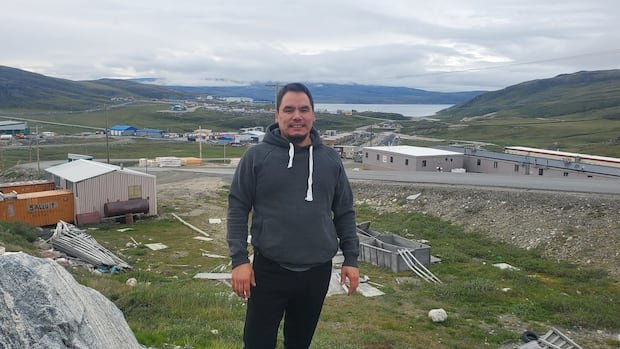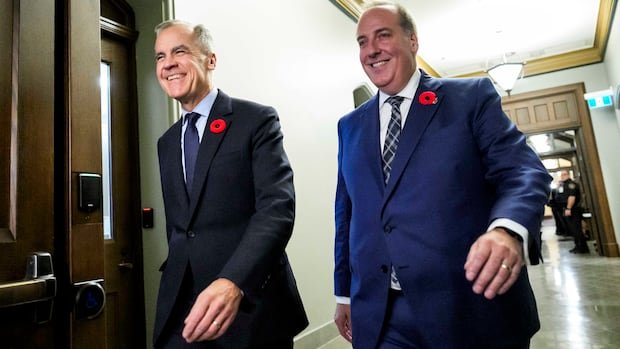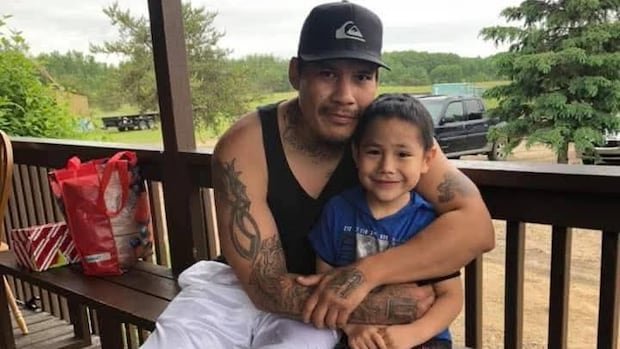A week before his 19th birthday, Johnny Saunders fulfilled his childhood dream of becoming a police officer, but it didn’t turn out as he expected.
Saunders received a new uniform and the keys to a truck, he said, remembering the moment he joined the Nunavik Regional Police, which at the time was called the Kativik Regional Police Force.
“We were all naïve, but I guess we all dreamed of trying to make a difference,” Saunders said in an interview.
He was among several Inuit officers recruited and trained for police work in their hometowns in the early 2000s.
But two and a half years later, when he was 21, Saunders was losing hope, “taking stress leave after leave” and drinking heavily to cope.
He also felt as if he were being seen as a stranger in his own community in Nunavik, an Inuit territory in northern Quebec.
In some cases, his time as a police officer altered his relationships with loved ones, such as when he was forced to arrest his cousin for a minor crime.
It’s something he still regrets.
“I looked him in the eyes and told him he had to do it,” Saunders said.
“Putting your cousins in the handcuffs you grew up with, you know how unnecessary that is, but the law says you have to do what you have to do.”
Feeling overwhelmed and without police support, Saunders quit his job. And he wasn’t the only one.
There has been a decrease in the number of local police officers on staff.
With more non-Indigenous officers, Saunders says Nunavik has become a rotating training ground for police and “you’re always dealing with the new guy.” who do not always fully understand the people they serve.
Advocates say that has contributed, over time, to an erosion of trust in communities and an increase in violent interventions.
According to data of the provincial police control body, police officers in Nunavik are involved in 73 times more fatal shootings than the provincial average.

Earlier this week, residents of Nunavik communities participated in marches to denounce police brutality.
Some residents say they remain concerned about safety a year after police shot and killed 26-year-old Joshua Papigatuk and wounded his twin brother in an incident that made headlines across the province.
Only 3 of 151 officers in Nunavik are Inuit
Another former police officer who joined the region’s police force in 1999 says the way forward must include recruiting more Inuit and focusing on community policing models.
CBC News agreed not to reveal his name because he fears facing consequences for speaking out against police.
He says support for Inuit officers was lacking and working in communities long-term was unsustainable.
“Looking back, it was the hardest thing in my life: policing your own community,” he said.
“Many of us who were recruited then are no longer here.”
Some former colleagues have passed away and others continue to struggle with the effects of the trauma they suffered while they were officers, he says.
“The strength has not improved, but has gotten worse,” he said. “Our people do not serve us. The people of the south serve us, who do not take into account our culture, our way of life.”

Police also face challenges in Nunavik. In 2024, crime rates in the region were about 15 times higher than the rest of the province, according to Statistics Canada. There are also tough struggles with addiction and suicide, compounded by intergenerational trauma and homelessness.
The regional police recognized in a recent report that recruitment and retention were “a huge and ongoing challenge.”
In 2005, eight Inuit officers worked with local police, according to a Kativik Regional Government (KRG) Report.
Two decades later, in 2025that number was reduced to three Inuit officers out of 151 serving in the region.
In June, the KRG passed a resolution calling for an audit of the Nunavik Police Service. The resolution called for a review of police operations and ways to make police better reflect Inuit culture.
Police Chief Jean-Pierre Larose has said he fully supports such a review. He has also spoken out about the Nunavik Police Service’s lack of resources. Larose also recently said he would like his officers to become more involved in the community, saying he wants to “have a better relationship and build more trust.”
KRG did not respond to a request for comment to CBC News for this story.

In an emailed statement, Rémy Charest, spokesperson for The Quebec Ministry of Public Security said it will be available to support, advise and facilitate the implementation of the police audit results.
Charest said police officers must complete two training courses offered by Laval University on Inuit culture and indigenous realities.
“Maintaining good relationships with the community is the foundation of a community policing model,” Charest said.
Calls to disarm the police
Some residents are calling on police officers to no longer carry lethal firearms in the countryside.
It’s one of the demands listed in an online petition co-signed by the families of two men killed in police-involved shootings in the region this year.
Their lawyer, Louis-Nicolas Coupal, says the families requested to meet with Prime Minister François Legault, but the government “directly did not respond.”
The families have also not heard from Ian Lafrenière, Minister of Public Safety and Minister responsible for First Nations and Inuit relations.
“The murders need to stop,” Coupal said. “The province of Quebec has failed to provide adequate police and judicial services to Nunavik for many years.”
He says immediate reforms are needed and suggests the implementation of non-lethal weapons.
Guns were slowly introduced into the region. in the late 90sand the weapons available to police became more powerful, according to a report prepared for Public Safety Canada.
In Saunders’ two and a half years as an officer, he says he never laid a hand on his gun. He says he used de-escalation tactics.
Responding to calls heavily armed with rifles or assault weapons is not the right tool to de-escalate tension, says Olivia Ikey, an advocate who helped organize the Nov. 4 protest against police brutality.
“We understand that there are [are] Weapons are needed,” he said, and then added: “But at what cost? How do we manage that?”
He made the jump from his hometown, Kuujjuaq, to Montreal six years ago with his family.
Ikey says it’s getting dangerous and that Inuit are “terrified of police officers.”
“We can’t call police officers when we need help. We know things will get even worse when we call,” he said.
‘Do I want this to be happening to my daughters?’
Suzy Kauki, who lives in Kuujjuaq, says her family experienced this firsthand in 2020.
Kauki says that during a police operation responding to another girl who was in crisis, officers pointed guns at her 11-year-old daughter, Harmony.
“They held her on the balcony of our house with her hands up and the police officers pointed semi-automatic weapons at her,” Kauki said.

It is an example, he affirms, of how the police model falls short.
Kauki has long been involved in police reform and advocacy within the justice system in Nunavik and was another of the organizers of the memorial march against police brutality.
Kauki doesn’t always remember it being like that with the police.
Upon returning to Nunavik with her three daughters after continuing her studies in Ottawa, Kauki said she noticed a major disconnect between police and the communities they serve.
“As a mother, do I want this to happen to my daughters or do I want this to happen to my granddaughters? Is this the kind of environment we are going to raise our children in? [in]?”
People no longer make time for others, Saunders says, comparing how policing approaches have changed since his time in the police force.
“People don’t interact, people don’t look each other in the eye,” he said.
Saunders also found himself on the other end of policing: arrested in 2014 after becoming violent.says.
“There wasn’t enough support for what we were going through,” he said.
“The things we got to see… you weren’t necessarily prepared for that.”
Saunders, now a musician, uses his guitar as a way to find healing from his experiences and not “let shame hold me back.”









